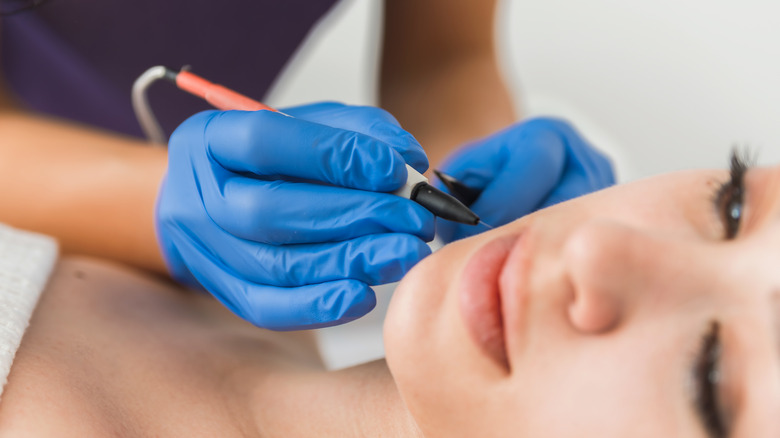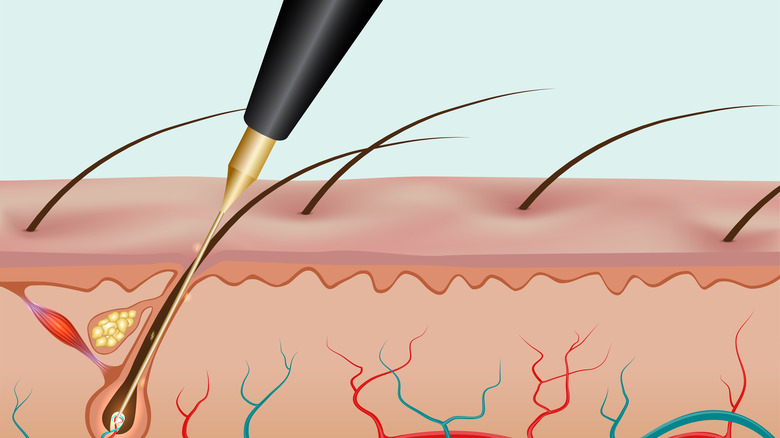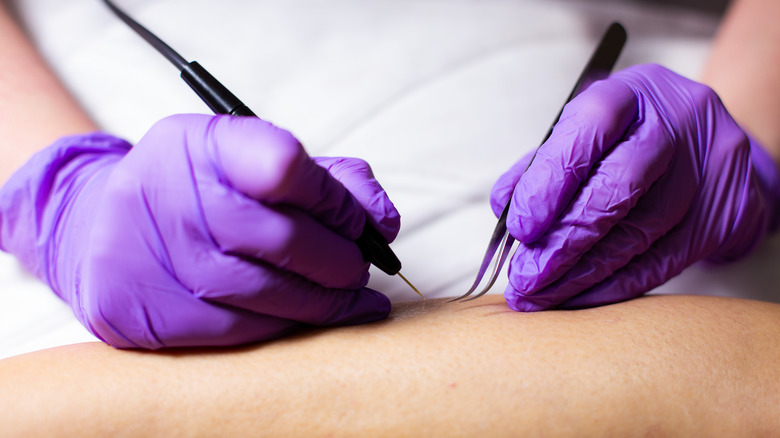Your Guide To Electrolysis Hair Removal
Whether you've got thick hair, sparse hair, or fast-growing hair, there is a method of hair removal suited to everyone. If you love saving time and money, hair removal creams like the fan-favorite Nad's 3-in-1 Hair Removal Body Butter are a great go-to. And if you're a fan of exfoliating while achieving smooth, hairless skin, chances are you prefer waxing or sugaring. But it can get tiring having to deal with the messy process of using hair removal creams or the pain that comes with waxing sessions. And so you may seek alternatives — longer-lasting hair removal methods to keep your skin hair-free. If you're at this point and like the sound of permanently getting rid of body hair, it might be time to consider electrolysis.
According to the Cleveland Clinic, electrolysis is a procedure where a thin wire or probe is inserted into the hair follicle. Once in, a small electric current is passed through the wire, which burns the follicle, and the hair is plucked out using tweezers. Electrolysis is the only permanent hair removal technique approved by the United States Food and Drugs Administration (FDA). It is a favorite among people transitioning and those with hirsutism, hypertrichosis, and polycystic ovarian syndrome, or PCOS (per Beauty Haven Belfast).
From the cost and cons to the number of sessions you might need, here's your all-in-one hair removal guide to electrolysis.
What are the types of electrolysis?
There are three types of electrolysis which are all similar but work in slightly different ways. There's the galvanic electrolysis, thermolysis, and the blend type. In galvanic electrolysis, an electric current passed down the probe causes the formation of lye, a chemical that destroys the follicle (per Aurora Electrolysis). Thermolysis uses radio energy at a high frequency to remove the hairs instead. And finally, the blend method combines galvanic electrolysis and thermolysis.
Each style has its pros and cons. For example, the galvanic type is excellent for coarser follicles, while thermolysis is faster and doesn't take as much time as the other methods (per Hair Free Life). Be sure to talk to your electrologist (who should be both licensed and qualified) about what is best suited to your skin and hair type. And remember, feel free to ask questions about any parts of the process that seem unclear to you.
The cost and length of electrolysis
Like waxing, laser, and other hair removal methods, the number of electrolysis sessions you need depends on how fast your hair grows, which, as we know, varies from person to person. But, Electrology 3000 does confirm that you can expect anything between 10 to 14 sessions for complete removal. Sessions can be as frequent as once a week or can be spaced out with four to six weeks between them. However, the repeat visits can make electrolysis a bit exhausting and time-consuming, especially if you're used to quicker hair removal methods (per Ormond Beach Dermatology).
Similar to the variation in the number of treatments you require, the cost is determined based on the clinic's location, how long the procedure takes, and your electrologist's experience and qualifications. The level of detail and care it requires also put electrolysis on the pricey side (and it can get even more expensive the thicker or fuller the hair is). With all this in mind, per Derrow Dermatology, your sessions can cost anywhere between $30 to $100.
Will it hurt? Are there any side effects?
Electrolysis involves electricity, permanent follicle damage, and a probe — it's bound to hurt a bit. While some people find the procedure painful, others describe the feeling as a stinging sensation or do not experience pain at all (per Coastal Electrolysis). The good news is that numbing gels and painkillers exist. Your electrologist might apply a numbing agent or local anesthesia to help with the pain before going in with the probe. And for possible side effects right after treatment, Reyuva Hair Electrolysis names scabbing, scarring, redness, and burning as the most common. But as long as you follow post-electrolysis care tips and don't touch your skin often, there is little to no need to worry about complications from the procedure.
Electrolysis is a method that works fine for all kinds of hair textures, skin types, and even people living with conditions that cause excessive hair growth. But its versatility does not extend to people with health conditions that cause excessive bleeding. According to Aedit, electrolysis is a no-no for people with hemophilia, keloid scarring, and skin infections. People on anticoagulants and those who have had skin procedures recently are also not fit for this method of removing hair.
What do I need to avoid after a session?
Our ultimate post-electrolysis care tip? Leave your skin alone. Remember the side effects — scarring, scabbing, redness, and burning? You might experience them and become tempted to touch or itch it to ease discomfort. But all that will do is cause more harm to your already sensitive epidermis. As Bare Electrolysis explains, scratching your skin or picking at the scabs can lead to permanent scarring, which would unfortunately be a long-lasting effect for a temporary problem. Instead, ice your irritated areas and use topical antibiotics to keep the site clean and scab-free.
Bare Electrolysis also recommends staying away from the sun and avoiding makeup for at least a day after the session. The sun's UV rays can aggravate the skin and cause permanent scarring and hyperpigmentation. On days when sun exposure is unavoidable, be sure to use a broad-spectrum sunscreen with at least SPF 30.
How long does it last? Will my hair come back?
In electrolysis, the hair follicle is burned, so there is no regrowth, making it permanent. However, your consistency with the sessions and your hair growth cycle are huge determinants for the best results possible. The hair growth cycle consists of three phases: anagen, telogen, and catagen. Anagen is also known as the growing phase, catagen is the regressing phase, and telogen is the resting phase (per Grow Gorgeous). As Alite Laser explains, electrolysis kills off follicles in the growth phase but will not do much for hair in the resting phase. Therefore, your first session will prevent regrowth by destroying the hairs in anagen, and then regular sessions will burn the hairs that were in telogen at the time of the initial treatment. So, regrowth can happen, but perfect attendance guarantees a hairless finish.
The many sessions and the idea of pain can be a bother, but for the promise of permanently hair-free skin, electrolysis has earned many fans.





